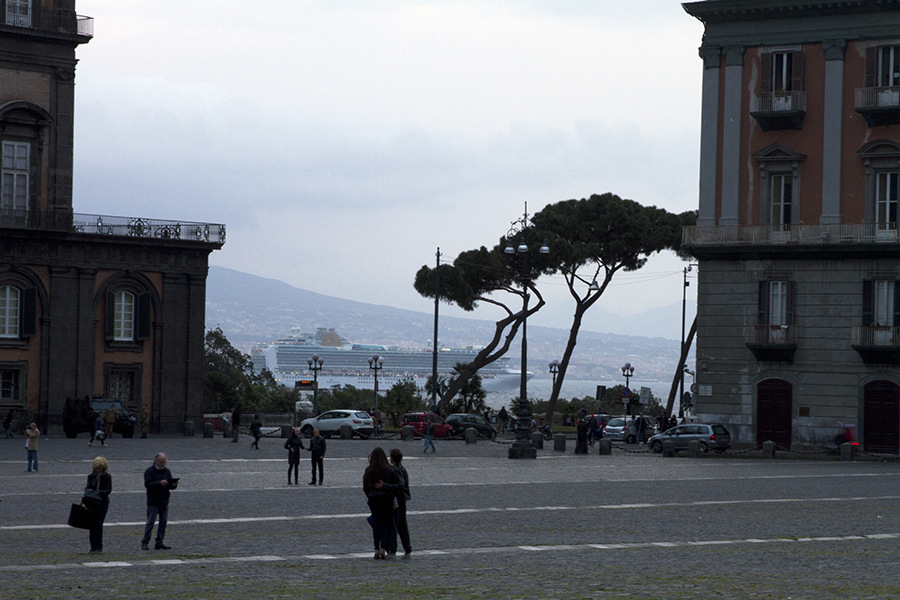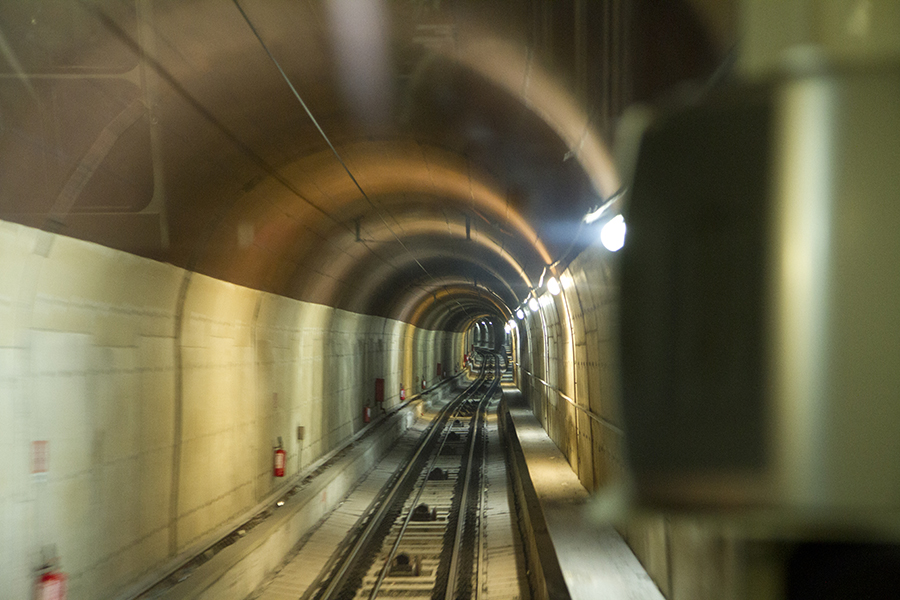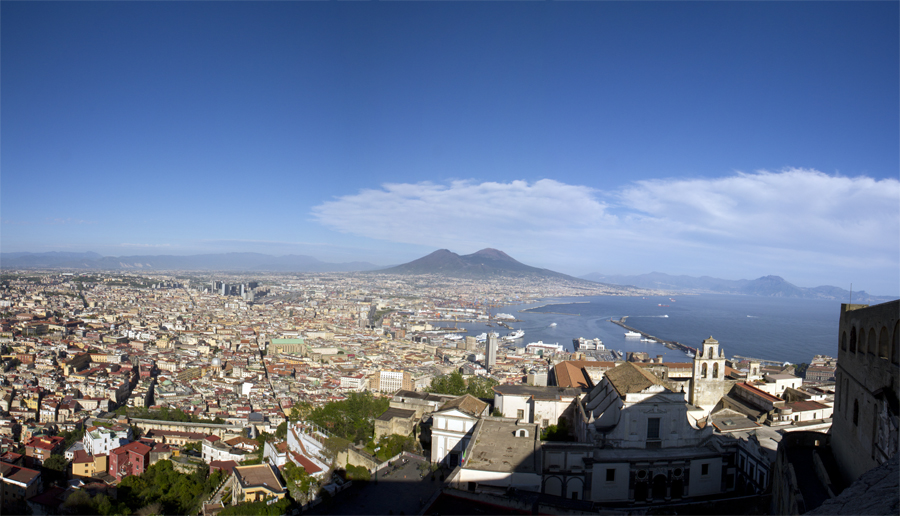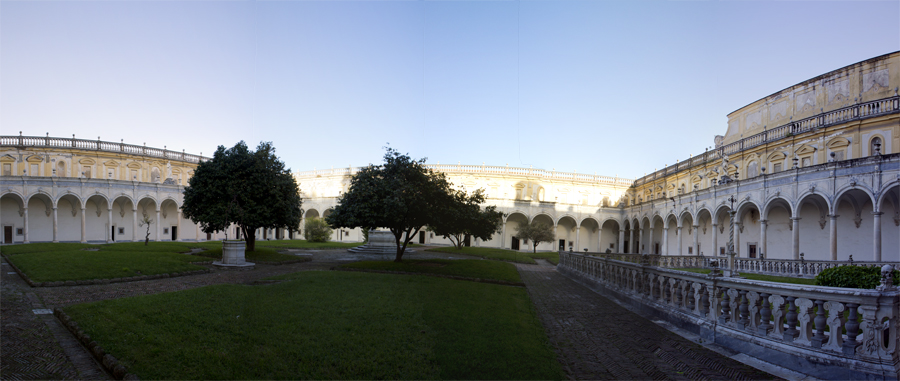If it is not obvious already from the amount of time that I spend there, I love Italy. I have been there many times and every time I do, I come back more enchanted and convinced that I should come again.
In all my previous trips, I had spent a grand total of 3 or 4 days in the area around Naples, and all of that when I was 11 and 13 years old. I had memories of Paestum, Monte Cassino, Heculaneum and Castel del’Ovo. But these were very vague, and I was not sure what was what any more.
Bee and I decided to spend the time between Easter and May Day in and around Naples so that we could take advantage of two holidays. We arrived in Naples on 19 April, rented a car and drove to our hotel right in the center of the city. The hotel was situated on a pedestrian street and so had left good instructions of where to park. We found the parking and walked to the Hotel Il Convento. We had booked a room with balcony, at the very top of the hotel and it was very nice.
We went for a walk in order to discover the neighborhood. On Piazza Plebiscito (Suffrage Square), we saw this sight of a cruise ship leaving harbor. Naples and, as we will see later, Sorrento are major stops on the cruising Italy scene.
There was not much going on in the low town around the square, so we decided to go up with one of the old cable cars (Funicolare Centrale) up to the Vomero Hill. The car runs underground all the way up to the top of the hill.
We first went to visit the Castel Sant’Elmo, located right at the top of the hill and built by the Spanish in 1538, with spectacular views of the city and Mount Vesuvius just behind it. At first, I was not sure that it was Mount Vesuvius, as I did not remember the second “hump” on the side of the mountain, and all the photos and paintings of the volcano showed it more with the typical conical shape. However, comparing with the location of Vesuvius on the map, and when we went there, I can confirm that the big mountain just outside the city is indeed Mount Vesuvius.
Here is a wider panorama of the Bay of Naples. Vesuvius is on the left and then you can see the low hills of the Amalfi Peninsula. The last two dark spots on the right of the photo are the two hills of Capri – we had excellent visibility that day as the sun started to come down.
After the castle, we went to the Certosa di San Martino, located only 100 m from the castle. It used to be a Monastery, build in the 14th century and rebuilt in the 17th. A constructed view (180 degrees) of the cloisters inside the monastery – this is Chiostro Grande.
There are ancient carriages used by the former occupants of the Certosa – I guess the chief abbot was used to travel in style!
The Certosa houses a significant art collection from early Neapolitan artists.
and has an impressive collection of “Presepi” or Nativity Scenes. These are very elaborate and often comprise several hundred individually carved figurines.
The next day, we decided to re-visit a place that had really impressed me the first time I went there when I was only 11 years old. It is probably one of the many elements that led me to become particularly interested in the history of World War II. We went to Monte Cassino and made a first stop at the Polish Cemetery, just below the Monastery. The Abbey of Monte Cassino was occupied by the Germans during WWII and was one of the key hinges to the last defensive line below Rome. The allied had quickly conquered the bottom of the boot of Italy after their landings in and around Salerno, just South of the Amalfi Peninsula. However, they were eventually stopped completely just before Rome, and after days and weeks of attempts, Monte Cassino was still held by the Germans. The main fighting force in the area was Free Polish Regiments and they suffered heavy losses. They were honoured after the war by having the nearest cemetery to the Abbey itself.
It is an inspiring sight – it houses over 1000 graves of Polish soldiers and officers who died storming the fortress of Monte Cassino.
We were not the only visitors. As you can see from the tombs in the foreground, quite a few Polish Jews had joined the Free Polish Army.
A better photo to give you an idea of the scale – each level holds several hundred tombs and there are eight separate levels.
The commanding officer of the Polish Forces during the Italian Campaign, Wladyslaw Anders, died London in 170 and requested to be buried with his troops in Monte Cassino – his wish was granted and his tomb is right at the front of his former troops.
The Monastery itself was completely destroyed by the Allied forces during the Italian campaign of WWII. It was faithfully rebuilt after the war from the original plans and now looks superb. One can see why it was such a strong defensive position and why it was so difficult to eliminate the German forces holed there. Even now, the only way up is a very narrow lane that twists around the hill; the large tour buses certainly do not help the traffic. We arrived early, and hoped to get a guided tour of the monument.
Only large groups can book ahead. We needed to go to the guide office and hope for luck – and luck we had. They were expecting an English group of about twenty people and asked us to wait – they would ask the group leader if we could join the visit with them. The group turned out to be a school group of Australia on a Religious and WWII Tour of Europe. What better place to join the two than Monte Cassino. They were glad to have us join, so we ended up with a really great tour, as only the two teachers and the two of us were really interested in the tour and were asking questions of the guide.
The main stairs from the entrance courtyard to the Cathedral are very impressive.
The museum houses some beautiful art pieces from the middle ages.
After our visit, we tried to get some lunch and found out that the town of Monte Cassino completely shuts down on Easter Monday. We could not find a place to sell us any food other than a chocolate shop, where we had chocolate flavoured tagliatelle with tomato sauce. I never thought I would say this, but not all uses of chocolate are good – chocolate with tagliatelle? I will pass next time.
On the way back to Naples, we decided to stop in a very small town along the Mediterranean coast called Sperlonga. Just outside of Sperlonga, archaeologists have discovered the remains of one of the many villas of Tiberius which includes a grotto that was supposed to be used for parties and orgies that Tiberius was famous for. We had to see that!
The house itself was ideally situated near the beach.
The grotto was faced by a swimming pool where you can just imagine that scantily dressed young men and women would swim for the pleasure of Tiberius and his chosen few.
We finished the day in Gaeta, where we had booked a table at this restaurant called Ristorante La Garitta, on the road to the Santuario della Santissima Trinità. After the fiasco in Monte Cassino, we were very happy to have booked, but it took us several attempts at finding a parking space near the restaurant as the place was absolutely full. We had picked this restaurant for two reasons: (1) It was highly recommended by Trip Advisor and (2) it faced West from above the town and therefore there was an excellent chance at an interesting sunset.
The sunset did not disappoint. Once again, I shot many photos as the sun slowly worked its way down. It is always a conflict between getting an interesting foreground, and an interesting background for the sunset – otherwise, it is just a bright light in the sky!
On this panorama, birds helped me to add something in the middle of the picture.
You always have to have one shot where the sun is partially hidden away. In this case, I could have taken a picture where you can see the details of the land, but then the sky is overexposed and you cannot see any of the colours there. I prefer this one slightly underexposed where the sun and the sky are the main focus.
By the way, we had a very nice meal in the restaurant and got stuck in a traffic jam some 60 km from Naples on the way back – not sure what caused it. We ended up using the GPS to leave the coastal road and do a 30 km detour back to the main highway and we arrived in Naples 30 minutes before the car park where we left the car closed for the night!
The next day we visited Naples again – we decided to alternate between road trips and visits of Naples.
The street below is typical of the neighborhood where our hotel was. Narrow streets, mostly pedestrian, with the occasional car or small delivery van and lot’s of scooters. The laundry still hangs across the street to dry.
Below is the bottom station of another cable car that goes to the Vomero Hill. Around it there was supposed to be a daily market, but we did not see very much.
We went to visit the Basilica di Santa Chiara – one of the oldest churches in Naples. Inside there is a wonderful cloister, as always very peaceful compared to the rush outside.
The decorations of the cloisters have been preserved – there are also mosaics in the main Basilica which are worthy of Monreale in Sicily and Ravenna in Northern Italy.
We also found out that Rome does not have a monopoly on catacombs – the best preserved ones are actually just outside of the center of Naples, on the hill that leads to the Palazzo di Capodimonte, on the hill called Capodimonte, or top of the mountain. These are the catacombs of San Genaro, named after a local saint who was buried in the catacombs for a while, before his body was stolen, recovered and then put in a safer spot.
Visits are with a guide only and start every hour. We had just missed a visit two days ago when we first came and so this time we made sure to arrive early.
The catacombs were hidden for many years and have only recently been restored and re-opened to the public. A group of former archaeology students from Naples University have contracted with the city to manage the concession and they charge for their visits in order to make money to maintain and restore the monument.
In what is now used as a chapel, our guide explained how they have to fight “City Hall” and the city’s notorious bureaucracy for everything they want to do and every penny in subsidies that they have a right to.
It was a very interesting visit and I am happy to support the efforts of young people who want to restore and maintain historical monuments.
Another day, and another road trip, to Caserta this time.
The King of Naples and the Kingdom of the Two Sicily Charles III of Bourbon decided to build his palace in the town of Caserta to rival Versailles. Caster ya is about 1 hour now outside Naples. At the time, it probably took all day to get there on horseback.
After Napoleon Bonaparte conquered Italy, he installed his older brother Joseph-Napoleon Bonaparte as the King of Naples and he made significant renovations to the original building, especially the inside. Joseph’s successor, Joachim Murat, who was Napoleon’s brother-in-law, made even more extensive (and expensive) modifications. The inside has remained essentially how they would have left it even though the palace continued to be used until the early 20th century.
The style is French Baroque! and Grandiose!
There is a room near the royal apartments where several models are kept. This one is particularly interesting, as I am not sure what it could be used for, other than as a substitute for locks to raise and lower ships from one level to the next.
Further down the hall, there are two cribs that were actually used by the “Royal Babies”. I am not sure that I would be happy waking up with a giant angel threatening me from above. I am afraid that I do not remember who built these and for whom, but they are very beautifully made.
The Royal Bed Chamber – these people took themselves quite seriously.
There is a spectacular Prespio in the museum (there are actually several) – this is just a detail of the hundreds of figurines that make up the nativity scene – in this case a street orchestra. Notice the Trombone Player and how hard he appears to be blowing in his instrument.
The gardens maintained the original design of Charles III and his architect the Neapolitan Luigi Vanvitelli. The waterfall in the distance is actually more than 3 km from the main palace and there are a number of other fountains to break up the monotony of the walk between here and there. The weather was not the best, with occasional showers and quite cold. But we decided to keep going.
Here is the fountain of the three dolphins – we are about 1/2 way to the major water fall in the back.
The second fountain is the Fountain of Margherita – no explanation as to where the name came from…
This is the one that I remembered, vaguely. I remembered the stairs on the side, the rectangular vasques – but I thought the Reggia was actually at the top of the fountain, like other palaces I have seen in pictures… I guess that more than 40 years can affect memory little bit.
Here is the view from the top looking back at the Reggia – still 3+ km
After Caserta, we went to Pozzuoli, at the Northern end of the bay of Naples. As we were looking for the main attraction, and especially a way to get in (at our first attempt, there was very large RV blocking the only entrance to the campground, and parking lot. Yes, I say campground and I will get to that later. As we searched for an alternate parking space, we saw sign towards an Amphitheater, and therefore, in order to give more time to the RV to extract itself from the gate, we decided to go for visit.
The arena of the Amphitheatre of Flavio, in Poteoli (the Roman name of Pozzuoli) is the third largest in the Roman world and had a seating capacity of 20,000 spectators. This area of cement actually consisted of vaulted ceilings of substantial underground chambers. It was covered in sand to make for a softer landing and facilitate cleaning. The maintenance of the arena was the responsibility of slaves, often African, who had to rake the sand and keep it damp so that gladiators and spectators were not inconvenienced by dust. Water was sprayed onto the sand using small water skins, since too much water would turn the surface into mud. It was delicate work.
Eventually, we made it to the main reason to go to Pozzuoli. No, it is not the campground, but that is the way into the Solfatara, Italy’s least known volcano (the fifth volcano in Italy after Vesuvius, Etna, Stromboli and Volcano). Next to the closest campground to Naples, you have an actual crater situated right at sea level. In the crater, there are boiling mud pools and one area that is still smoking with a strong smell of rotten eggs.
A closer view of the remaining hot gas spring. You can see the yellow marks on the side of the hill where sulphur is deposited.

Before leaving Naples and heading for Sorrento, for the second half of our trip, we stopped again at Piazza Del Gesu Nuovo after another attempt at the market. With the clear blue sky, we had an excellent view of the column at the center of the square with the Basilica of Santa Chiara in the background.

We had an uneventful drive to Sorrento (other than my GPS trying to get us to go the wrong way, believing that the main road was closed to traffic) and arrived at the Hilton just above Sorrento. We had booked 10 nights on points and since we are regulars in Hilton Hotels, we received an upgrade to a room with this view! You can just make out the darker shape of Vesuvius in the center of the picture – there will be better views than this.
With this preview of the next installment, I will now leave you until next time…
(883 Page Views)








































